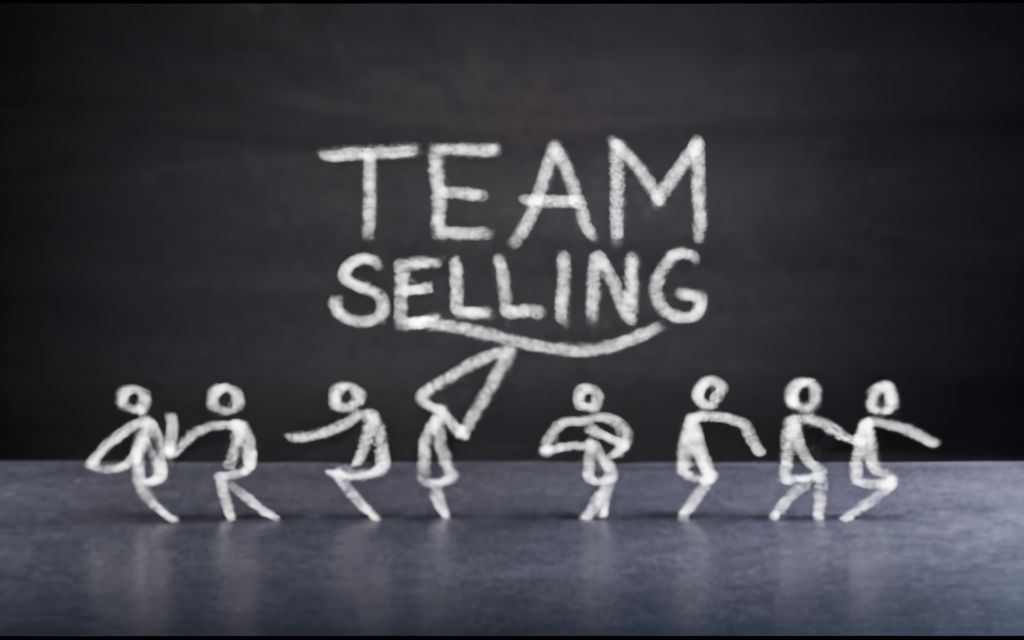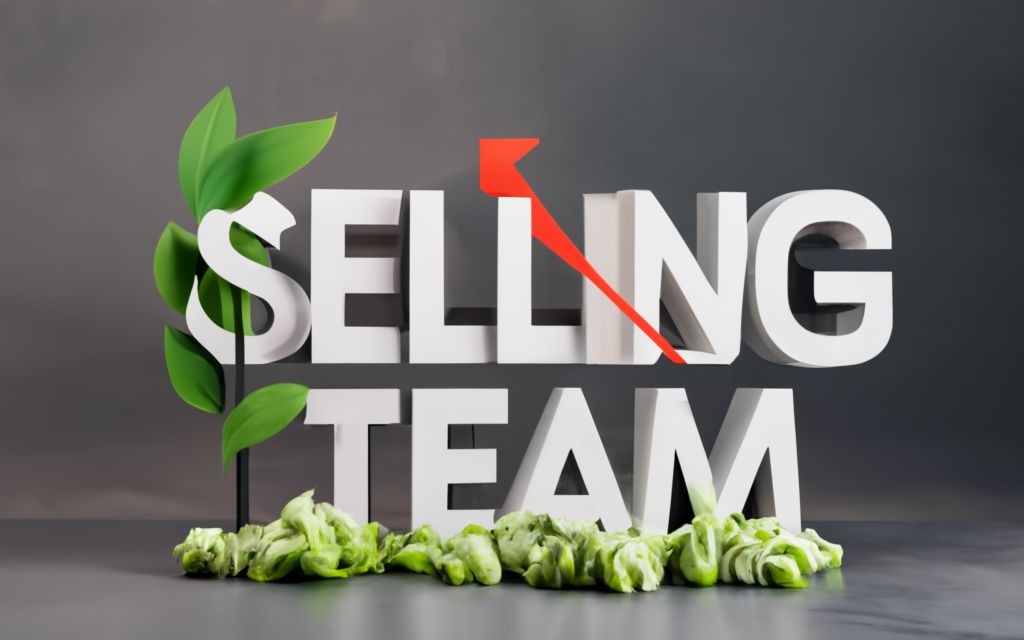Are you ready to shatter your sales team’s status quo? The solo superstar model is now a thing of the past. The future is collaborative — it’s team selling. Discover how to implement a team selling approach to develop winning solutions, shorten sales cycles, and deliver 5x faster revenue growth. In this comprehensive guide, learn powerful team selling strategies, tools to enable seamless collaboration, and ways to motivate team behaviors. Avoid common pitfalls that derail team sales success. Embrace the collective power of team selling to exceed targets and create unbeatable customer experiences.
What is Team Selling and Why it Matters?
Team selling is a collaborative sales approach where two or more salespeople work together to close deals, rather than handling accounts solo. It involves leveraging the collective skills, experience, and relationships of a diverse sales team to provide prospects with the ideal buying experience.
In team selling, the accountabilities are shared across the team and the goal is winning the business together, not competing internally. This approach contrasts with traditional individual selling models where reps act independently in pursuit of sales targets and commissions.
Some key benefits of team selling over individual selling include:
- Broader Sales Reach: Each team member brings unique value to the table. More perspectives mean more sales opportunities can be uncovered. Research by Gong.io found that having multiple seller participants on at least one sales call increased deal conversion rates by 258%.
- Problem Solving Agility: With a team, sales challenges can be addressed faster. Someone can look up specifics on a product feature while another keeps the prospect engaged. Individual sellers have a narrower lens.
- Credibility and Trust: A team signals commitment and expertise to buyers. Seeing collaboration across departments like support, operations and product breeds confidence. Solo sellers seem limited.
- Realistic Self-Assessment: Individuals have biases. With teammates, sales reps get instant feedback on performance, missed opportunities and improvements.
Team selling is most effective for complex, high-value accounts where subject matter experts from across the organization can provide specialized knowledge. Typical scenarios where team selling helps includes:
- Large Account Size: When a deal size is 5-10 times the average, tapping cross-functional resources makes sense. More points of contact increase win probability.
- High Complexity Deals: Solutions with elaborate technical requirements or integrations will benefit from technical experts chiming in.
- Shortened Sales Cycles: Deals needing accelerated closure can benefit from more firepower through team selling.
- New Market Entry: Unfamiliar accounts and segments are unlocked faster by leveraging institutional knowledge via teams.
- Limited Internal Bandwidth: When sales reps are at maximum capacity, distributing workload across teams prevents losing out.
- Advancing Customer Relationships: Team selling allows identifying upsell opportunities and educating across the line.
In essence, team selling simplifies selling complex products or solutions and high value accounts by streamlining communication and delivering exceptional buying experiences. According to SiriusDecisions, 67% of B2B deals require team selling.
An example illustrates the power of collaboration. A mid-sized software company selling a $500k data analytics suite to a Fortune 500 retailer hit roadblocks during technical scoping sessions. The sales rep got the product manager involved. Jointly they mapped capabilities to the client’s needs and addressed security and infrastructure concerns. This built trust and led to a winning proposal.
Without support, the rep would have struggled to close this complex sale. Team selling expanded the capability to deliver value. The different perspectives allowed customizing the pitch, pricing and SLAs as per the prospect’s expectations.
Team selling matters because buyers want advisor relationships, not vendor pitches. A collaborative approach shows you understand their business and are invested in their success. Instead of competing internally, sales teams need to cooperate to win externally. Aligning complementary skills and information makes teams greater than the sum of their parts.
Here is the 2100 word section on “How to Implement Team Selling Effectively”:

How to Implement Team Selling Effectively
Getting team selling right is crucial to maximize its impact on sales outcomes. Careful planning and execution helps reap the collaboration dividends faster. Here are some best practices to build a high-performing team selling approach:
Choose the Right Team Selling Strategy
There are two popular structures to consider for organizing team selling:
Sales Pods: In this cross-functional structure, salespeople, managers, and other department heads like marketing, product and engineering collaborate in real-time on accounts. Communication is frequent, with quick brainstorming sessions as required.
Assembly Line Model: Each lead is passed down a sequenced sales path – from SDRs for initial qualification to account managers for nurturing to customer success for adoption. The benefit is specialization at each stage.
The assembly line works for relatively simple products while complex solutions need the agility of sales pods. Depending on the sales cycle steps and handover points, choose an optimal path for passing accounts between functions.
Map the workflow to visualize how leads will traverse the revenue engine from lead to customer. Highlight areas of potential friction. Aim to hand over accounts from one stage to the next without dropping the ball.
Clarify Team Member Roles
Align individual responsibilities clearly before collaborating on an opportunity. Document details like:
- Primary sales contact owning the account
- Secondary contacts supporting deal execution
- Subject matter experts to engage and when
- Hand off points between functions
Ideally create a responsibility matrix or RACI chart for team selling. This visual map denotes who is Responsible, Accountable, Consulted and Informed for key tasks. Such clarity allows seamless transitions without duplicating work or losing track of accounts.
Establish a Clear Reward System
Motivating team members is challenging when contributions are uneven or less quantifiable than individual sales. Create a compensation plan rewarding collective outcomes rather than just individual performance.
Consider activity-based incentives like referral fees when team members bring in new accounts or support conversions. Or implement a revenue sharing mechanism tied to team sales targets.
Beside monetary rewards, enable social motivation through peer recognition, sales leaderboards celebrating team efforts and non-cash prizes. Maintain transparency around reward metrics. Fair systems sustain team spirit.
Leverage Account Roadmaps
Complex sales involve many moving parts across an organization. Account planning documents ensure everyone has the full picture.
Account maps visualize known stakeholders, their priorities, pain points and engagement history. They highlight areas needing attention for progressing an opportunity.
With a shared understanding, teams avoid working at cross-purposes. They instead coordinate their actions to provide a seamless buying experience. Maintaining a living account plan saves time spent aligning distributed team members.
Enable Open Communication and Feedback
The free flow of information, knowledge and insights is the lifeblood of team selling. This requires cultural enablement, not just tools. Frontline observations by sales staff often contain customer clues missed by management.
Motivate sharing of qualitative hearing by making time for brainstorming sessions. Reward those who actively participate with career growth and recognition.
Capture post-meeting and quarterly deal reviews in tools like Salesforce for others to learn from. Maintain accessible archives of win-loss analysis.
Technology plays a key role too. Platforms like Slack, WhatsApp and Microsoft Teams enable always-on collaboration critical in team selling environments. Integrate them with CRM and sales engagement tools for a unified system.
Who Should Be Part of Your Selling Team?
While sales roles are the centerpiece, team selling allows surrounding them with other experts as needed. Some key members to consider are:
Sales Leaders: They possess valuable institutional knowledge and can clear roadblocks using executive influence. Their vision provides directionality to sales pursuits.
Marketing Specialists: They advise on positioning the solution for maximum appeal. Content and campaigns support sales motions.
Customer Success: They provide implementation and adoption guidance during later sales stages, ensuring suitability.
Sales Operations: They maintain systems and processes for scalability and effectiveness of team selling.
Technical Experts: They address complex questions on integration, architecture and use cases. This builds credibility, especially with IT buyers.
The above roles enter and exit the selling scene at suitable points in the workflow. However, some core sales roles form the foundation throughout the cycle:
- Sales Reps: They quarterback account control and primary prospecting.
- Solution Engineers: They prove technical fit and conduct product demos.
- Sales Managers: They strategize pursuit, contribute expertise and unblock obstacles.
Key Factors for Successful Team Selling
Getting team selling right involves focusing on some key ingredients:
Strategic Team Structure: Assemble the right skills, experience levels and cross-functional mix needed for the selling scenario at hand.
Visible Goals and Metrics: Establish transparent objectives, accountabilities and rewards for the team. Progress visibility fosters collaboration.
Shared Systems and Tools: Unified CRM, playbooks and collaboration software prevent siloed data and disjointed efforts.
Regular Reviews: Cadence touches for strategy, performance analysis and course corrections are invaluable for teams.
With these pillars in place, sales teams evolve into a well-oiled revenue machine. The diversity of thought propels competitive advantage while retaining role clarity. Customers benefit from customized solutions while salespeople get to operate in a motivating, performance-driven environment. The result is faster sales velocity and bigger, more profitable deals.

Team Selling Approaches for Different Sales Models
Team selling can boost sales performance for both inside sales and field sales models. However, the tactics need customized application based on how each function operates day-to-day.
Team Selling for Inside Sales Teams
Inside sales teams juggle high volumes of outbound prospecting and inbound leads. For them, team selling helps in the following ways:
Engage Leadership to Build Credibility
Cold calls and emails from individual SDRs have lower authority. But interactions directly from CXOs or sales management carry more weight.
Use automated outreach tools to deliver targeted emails and social messages from sales leadership. These establish credibility and get better engagement.
According to Salesforce research, 57% of buyers said sales outreach from leadership would positively influence their vendor selection. So put your execs in front of prospects. But ensure relevance – don’t overexpose leadership.
Improve Collaboration Across Departments
Inside sales teams tend to work isolated, just passing on leads to account executives. Collaborating with product, marketing and technical specialists improves context and conversations.
Have experts from other departments participate in discovery calls and demos. Customers appreciate learning wider perspectives beyond sales pitches.
This also helps position inside sales reps as true internal partners vs just lead sources. The improved rapport translates to referrals of new opportunities.
Leverage Specialists to Advance Complex Deals
Occasionally, inbound leads require advanced expertise like navigating technical requirements or purchase processes.
Roping in solutions engineers, architects and procurement liaisons prevents losing out on such leads. The specialists resolve blockers so SDRs can progress opportunities.
For instance, a demo with a solutions consultant may be needed to prove your solution’s architecture aligns to a prospect’s legacy systems. Or the SDR might bring in an account executive to leverage existing customer relationships while pursuing a new opportunity.
Inside sales success relies heavily on assembling the right complementary skills within arm’s reach through team selling.
Team Selling for Field Sales Teams
For field sales teams out meeting customers for much of the week, team selling provides an invaluable safety net:
Prevent Deals from Going Cold
Between customer visits, even the best field reps can lose visibility into accounts. Critical follow-ups might be missed.
By sharing pipelines with marketing and inside sales teams, they help keep opportunities nurtured through campaigns and appointment setting calls while the field rep is away.
Create a Competitive Advantage
Field reps are accustomed to siloed working. But combining forces with other departments results in better solutions.
For example, when an SE accompanies a field rep for an onsite meeting, they can collaborate real-time to tailor a superior demo matching the prospect’s environment.
This on-the-spot responsiveness is difficult for lone field reps, creating a teamwork advantage.
Field salespeople build strong individual customer bonds. But what if the rep changes jobs or is unavailable? Customers hate constant churn. This risk is reduced with team selling.
By maintaining robust account plans and having marketing and sales colleagues step in as needed, personalized experiences continue despite field changes.
The Ritz Carlton hotel chain epitomizes this – they promise consistency by empowering all employees to resolve guest needs, backed by common tools and training. Their motto is: “We are Ladies and Gentlemen serving Ladies and Gentlemen.”
Their core tenet? Give employees the knowledge, tools and empowerment to work collaboratively as a team to drive exceptional service. This philosophy holds invaluable lessons for field sales too.
How to Use Team Selling to Close Deals Faster
With team selling best practices in place, it’s time to apply the approach hands-on to accelerate your deals. Follow these proven ideas to close sales faster through collaboration:
Qualify Accounts Suitable for Team Selling
Ensure you apply team selling to the right deals – those large or complex enough to benefit from cross-functional engagement.
Some indicators an opportunity needs a team approach:
- Deal size over 5x your average contract value
- Purchasing committee with 5+ decision makers
- Technical evaluation involving 3+ IT experts
- High number of integration points or customization needs
- Sales cycle historically over 6 months
- New market or industry segment for your company
Conversely, smaller or simpler deals won’t need extensive team coordination. Use criteria like above to identify accounts meriting the investment of team selling resources.
Map Account Stakeholders Clearly
Once you commit a deal to team selling, thoroughly map out known contacts and relationships. Note details like:
- Reporting structures and affiliations
- Roles and responsibilities
- Influencers and decision authorities
- Known pain points or requirements
- Engagement history and outstanding needs
An account plan visualizes this data so anyone joining the pursuit has instant context without reinventing the wheel. Maintain the map throughout the cycle as a single source of truth.
Prepare Talking Points and Assign Roles Beforehand
Smoothly choreographing a team selling call requires planning. Before a joint customer meeting:
- Agree on top discussion points and priority objectives
- Map out roles and transitions for the session – who introduces whom and when
- Share profiles of attendees for personalization
- Confirm time allocated to each agenda item
- Prepare answers for expected questions
Leave no room for surprises that could create confusion. Having an orderly flow and cadence reinforces your professionalism.
Leverage Technology for Visibility
Access to a shared system of record ensures continuity. Sales technology like HubSpot CRM centralizes contacts, deals history, notes and tasks so the extended team stays in sync.
Collaboration apps like Slack facilitate open communication across sales, marketing and support. Enable seamless interaction between all customer-facing roles.
Practice Active Listening and Feedback
Team selling succeeds through responsiveness. Listen to prospects’ verbal and non-verbal cues. Pause proactively to invite feedback.
Welcome criticism about where your solution falls short. Turn weaknesses into strengths by soliciting suggestions to improve.
Capture feedback shared outside meetings too for broader improvement. Align the team on takeaways after each call to adjust strategies.
Beyond processes, team selling works through engagement skills. Mastering communication, facilitation and relationship-building makes cross-functional coordination smooth.
Some sample scenarios illustrate team selling in action:
1. Discovery Call Brainstorm
An enterprise SaaS company selling a $250k HR suite to a retailer hit hurdles while scoping integration requirements. The sales rep invited a solution architect to a discovery call.
The architect suggested APIs to seamlessly connect the retailers’ legacy payroll system with their HR suite. This expertise helped build technical confidence and progress the evaluation.
2. Executive GTM Strategy
A biotech firm was negotiating a large equipment sale to a pharma major. To secure executives’ attention, they scheduled a call between both companies’ regional sales heads.
This peer-level alignment got the deal fast-tracked for final sign-off. The collaboration and rapport between sales leadership was instrumental.
3. Proactive Account Planning
An ISV selling encryption software solutions designates “quarterback” reps for large accounts. They proactively assemble a 6-month plan and team for each multi-million dollar deal.
Before calls, they share context on stakeholders involved, conversation focus areas and role assignments. This preparation leads to structured interactions advancing opportunities smoothly.
4. Post-Call Reviews
A SaaS platform company starts every week with a team huddle. The sales leader shares positives and improvement ideas from the previous week’s customer meetings.
These post-call reviews allow everyone to learn and enhance skills. The team implements the most actionable inputs to refine approaches across the board.
As evident in these examples, team selling is not complex. Some upfront planning, role clarity and integrated tools is all it takes to reap big results. Adopting a team approach leads to tangible gains:
- Shorter sales cycles with accelerated deal movement
- Higher win rates through superior combined value delivery
- Larger average deal sizes with cross-selling and upselling
- Improved customer satisfaction and retention
- Increased referrals and halo effect on company brand
With team selling, the total becomes greater than the sum of parts. Are you ready to leverage its potential?

Pitfalls to Avoid with Team Selling
While team selling provides immense advantages, it also comes with potential drawbacks if not executed correctly. Be aware of the following pitfalls to avoid:
Unclear Roles and Responsibilities
Failing to define individual members’ responsibilities upfront is a recipe for discord. Without clarity, misalignment happens.
Suppose the sales rep assumes marketing will create collateral while the marketer expects sales to provide content. Gaps like this irritate customers.
Explicitly set expectations around who owns what tasks. Use RACI frameworks to denote Responsible, Accountable, Consulted and Informed stakeholders for key activities. Updated as changes occur.
Poor Communication Practices
Team selling depends on seamless exchange of information and insights across boundaries. But habits like not sharing notes, skipping meetings and siloed systems impair collaboration.
Sales may close deals without informing support or success teams. This leads to customer frustration later during adoption. Break these silos through protocols enforcing cross-functional transparency.
Unsuitable Accounts or Prospects
Wanting large deals is understandable. But not every account merits extensive team selling investment.
Throwing resources at a small transactional sale unlikely to expand can be an overkill. Profile accounts diligently before deciding on a team approach.
Equally important is assessing if the prospect values collaboration. Some only want to interface with their main sales contact and see teams as over-servicing.
Underutilized Team Members
Involving too many people in a sales cycle strains engagement. Each member needs a clear purpose.
Figure out whose input is really needed to avoid wasting expert time better spent elsewhere. Bound team size dynamically based on opportunity complexity.
Lack of Preparation and Coordination
Even with role clarity,inadequate prep leads to mistimed or redundant contributions in customer interactions lowering credibility.
Leave no room for surprises. Prep call objectives, agenda, talking points and transitions to weave a coordinated narrative. Sync beforehand and debrief afterwards.
No Established Way to Resolve Conflicts
With multiple cooks in the kitchen, disagreements can simmer within teams on strategies or credit. An absence of mediation mechanisms worsens matters.
Implement processes for airing and resolving disputes constructively. Reward team play and reinforce that no single role more pivotal than others. Look beyond titles.
Here are five scenarios illustrating team selling pitfalls:
Case 1: The Overeager Executive
An exuberant CEO decides to join an account manager’s renewal call without briefing. He ends up derailing the conversation with too many tangents. This flusters the customer instead of reassuring them.
Takeaway – Avoid inserting senior executives in seller-buyer dialogues without context. Brief them on objectives and ideal interaction style beforehand.
Case 2: Uninformed Support Team
While negotiating an enterprise deal, sales offers a visit from the VP of Support to reassure the prospect’s executives. But the surprised VP is unavailable that day.
Takeaway – Keep supporting teams fully updated on commitments you make involving them.
Case 3: Demotivated Team Players
A seller prioritizes her pet high-value account, preferring to handle it solely without team help. Her colleagues feel undervalued and disengage.
Takeaway – Recognition and rewards must be inclusive of team efforts, not skewed towards individual contributors.
Case 4: Disjointed Customer Handover
A sales rep closes a deal but fails to inform the account manager, handing customer queries during onboarding. This causes confusion.
Takeaway – Enforce complete context transfer, introductions and communication cadence in account transitions.
Case 5: Unqualified Complex Deal
Eager to grow revenue, sales pushes the company’s advanced platform to a small firm needing simpler solutions. The mismatch causes frustration.
Takeaway– Avoid over-engineering solutions. Assess account size, infrastructure and capabilities before proposing offerings.
These examples underscore why aligned communication, systemic coordination and cultural reinforcement of teamwork is non-negotiable for collaborative selling.
Left unmitigated, the risks highlighted above can not only result in losing deals but also strain engagement between internal teams and with customers. Lead with clarity, transparency and accountability to maximize team selling results.
Tools and Software to Enable Team Selling
Technology plays a pivotal role in effective team selling by enabling transparent communication, easy access to information, and centralized coordination. Consider leveraging these software solutions:
CRMs with Team Functionality
A shared customer relationship management platform allows sales teams to seamlessly collaborate by housing data in one place. Leading CRM tools like Salesforce and HubSpot CRM offer capabilities to enable team selling:
- Account Maps: Visualizeknown contacts, influencers, requirements, and notes.
- Automated Contact Updates: Alerts on role changes and trigger-based tasks.
- Activity Logging: Central feed of emails, calls, meetings, and notes.
- Custom Objects and Fields: Capture deal-specific meta-data.
- Opportunity Teams: Assign primary and secondary owners.
- Collaborative Notes: Cross-functional log of account insights.
- Task Assignment: Designate to-dos with due dates.
- Reporting: Analyze performance by team or individual.
Sales Engagement Software
Solutions like Outreach and Groove streamline outbound sales coordination via:
- Tagging and Routing: Route leads to suitable reps based on criteria.
- Templates: Maintain brand and messaging consistency.
- Approval Workflows: Ensure compliance for outbound campaigns.
- Sequence Collaboration: Teams build engagement cadences together.
- Time-Bound Tasks: Assign actions to complete by specified deadlines.
Meeting Tools with Collaboration Features
Applications like Zoom, Webex and Microsoft Teams facilitate collaborative sales calls with:
- Screen Sharing: Demonstrate solutions jointly.
- Digital Whiteboards: Brainstorm ideas in real-time.
- Recording and Notes: Improve via post-meeting review.
- Chat: Back-channel communication during calls.
- Breakout Rooms: Enable private team discussions mid-meeting.
Account Planning and Mapping Software
Specialized tools like Account Planning (HubSpot), Cloze, and Demandbase help visualize and coordinate complex, team-based account strategies through:
- Stakeholder Mapping: Profile buying committee members.
- Persona Linking: Tag contacts for easy segmentation.
- Progress Tracking: Mark milestone achievement.
- Playbooks: Define workflows for sales stages.
- Notes Capture: Create centralized account knowledge bases.
- Automated Data Enrichment: Surface relevant news, triggers, and social insights.
- Plan Sharing: Give all collaborators access.
Other Handy Tools
- Slide Sharing Platforms: Co-create presentations in real-time with tools like Google Slides.
- Mind Mapping Software: Build account vision documents together using MindMeister and collaborators.
- File Sharing Systems: Securely exchange documents through apps like Box and Dropbox.
- Real-Time Chat Apps: Communicate asynchronously across teams with Slack or Microsoft Teams.
- Webinar Platforms: Deliver compelling virtual briefings using GoToWebinar, ON24.
- Co-Browsing and Remote Support: Guide customers together through solutions like LogMeIn and Zoho Assist.
With the right mix of tools, sales teams can seamlessly interact, exchange insights, divide tasks, and track progress. Some best practices for effective usage:
- Maintain consistency across systems to prevent fragmented data.
- Integrate tools where possible for unified workflows and data flows.
- Limit access to customer information to only relevant team members.
- Train teams thoroughly on capabilities to maximize adoption.
- Monitor usage frequently and gather feedback on enhancements.
- Evaluate new features proactively for potential team selling benefits.
As tools mature with AI and automation capabilities, they can streamline team selling further by:
- Recommending optimal account penetration strategies through advanced analytics.
- Proposing team members to engage based on customer scenario and history.
- Providing conversational guidance during calls to coach teams in real-time.
- Automating administrative coordination activities behind the scenes.
Technology paves the way for scalable, consistent and institutionalized team selling practices. Choose solutions that foster transparency, easy collaboration and insight sharing across organizational boundaries.

Key Takeaways on Mastering Team Selling
Team selling provides a collaborative approach to drive sales growth and deliver exceptional buying experiences. Here are some key lessons:
- Team selling shortens sales cycles by bringing diverse skills and faster responses to prospects. Win rates improve through cohesive value communication.
- Choose opportunities wisely based on deal size, complexity and relationship potential to maximize return on team selling efforts.
- Build teams strategically around complementary skills and experience levels – both customer-facing and supporting roles.
- Clarify individual responsibilities and handoffs through device like RACI charts to prevent ambiguity and duplication.
- Motivate team behavior through rewards based on collective outcomes, recognition and constant feedback on improvements.
- Make account planning andenable transparent systems to seamlessly exchange information across teams and develop institutional knowledge.
- Schedule regular touchpoints for strategy reviews, win/loss analysis and post-meeting debriefs to continuously refine approaches.
- Avoid falling prey to pitfalls like poor role clarity, communication silos, conflict resolution gaps and inadequate preparation.
- Leverage technology like CRM, sales engagement, meeting and account planning tools to provide visibility and a unified ecosystem.
- Practice team selling skills like active listening, facilitation, collaborative problem solving and relationship building.
With strong foundations around process, people and technology, team selling amplifies results through aggregated team effort. Adopt a collaborative mindset and complementary skills focus.
Frequently Asked Questions About Team Selling
Q: What are the benefits of team selling?
A: Team selling provides many benefits including shorter sales cycles, higher win rates, increased deal sizes, improved customer experience, and greater competitive differentiation.
Q: When should you use team selling?
A: Use team selling for large, complex deals and accounts, deals with long sales cycles, technically complex evaluations, and scenarios requiring specialized expertise.
Q: How do you build a team selling approach?
A: Important steps include choosing a team structure, mapping account stakeholders, clarifying roles, establishing processes, implementing technology, and fostering collaboration.
Q: What tools help enable team selling?
A: Helpful tools include CRMs, sales engagement software, meeting collaboration apps, account planning systems, file sharing, and real-time chat.
Q: What are some pitfalls of team selling?
A: Common pitfalls include unclear responsibilities, poor communication, mismatched accounts, underutilized members, lack of preparation, and no conflict resolution mechanisms.
Q: How is team selling different from individual selling?
A: Individual selling involves a single salesperson managing the entire cycle while team selling leverages collaborative input from multiple roles.
Q: What skills are important for team selling success?
A: Critical skills include communication, relationship-building, facilitation, active listening, problem-solving, coordination, and collaborative competencies.
Q: How can technology enable team selling?
A: Technology provides a unified system of record, seamless collaboration, visibility across stakeholders, integrated workflows, and data-driven recommendations.
Q: How do you motivate team selling behavior?
A: Motivate through incentives based on collective outcomes, frequent feedback loops, public recognition, defined metrics, transparency, and reinforcement of teamwork culture.

